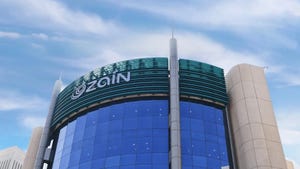French alternative operator shows that triple play can be a money-spinner. Investors see a 300% share price rise in 2 years
March 15, 2006

Anyone who invested in alternative French operator Iliad (Euronext: ILD) when it floated on the Paris exchange at €16.30 in January 2004 has the right to feel pretty smug today. (See Investors Go Mad for Free Shares.)
The company, which derives 80 percent of its revenues from triple-play service provider Free , saw its share price rise €4.20, more than 7 percent, to €61.90 this morning after it published its 2005 financial results. (See Iliad Reports 2005.)
For a company taking on Orange (NYSE: FTE) in the incumbent's own back yard, a 280 percent rise in the value of the stock is more than impressive.
Here's the reason for the healthy share price. Year-on-year revenues are up 47 percent to €724.2 million ($871 million), while net income is up 69 percent to €68.9 million ($82.8 million), higher than the €61.3 million analysts polled by Reuters were, on average, expecting.
Iliad's 2005 EPS (earnings per share) is €1.26 ($1.51), above the analyst consensus figure of €1.12 ($1.35). The company is paying a dividend of €0.20 ($0.24).
For the record, the other 20 percent of Iliad's revenues also comes from telecom services -- hosting, traditional voice resale, calling cards, and public wireless LAN access.
Iliad's numbers make for good reading, but it's the strategy behind the balance sheet that tells the real story, as, in many cases, Iliad has developed its own broadband access equipment -- DSLAMs and home routers/gateways -- rather than wait for the right equipment from a vendor supplier.
It has also been at the forefront of local loop unbundling in France, installing its own DSLAMs in France Telecom's central office. To date, it has its equipment installed in 675 of the incumbent's facilities, and has the key to the door of another 1,000 exchanges. That strategy costs money, though: In 2005 Iliad spent €207.7 million ($249 million), nearly 29 percent of its revenues, on capital expenditure.
But that decision to take control of its technology developments, as well as its marketing and business strategies, has resulted in massive leaps in subscriber additions, revenues, and profits.
Triple-play attraction
Iliad ended 2005 with 1,595,000 ADSL customers, an increase of 531,000, or 50 percent, from the 1,064,000 broadband subscribers it had on December 31, 2004.
At the end of 2005, Iliad had a 17.9 percent market share of the French DSL market, second only to France Telecom's ISP, Wanadoo SA , which had 49.5 percent of France's 8.9 million DSL users. And it's not as if Wanadoo were Iliad's only rival. At the end of 2005, Neuf Cegetel Group (Euronext: NEUF) had a 13.2 percent market share, with nearly 1.2 million broadband customers, while Telecom Italia (TIM) had 546,000 DSL users for a 6.1 percent market share, and T-Online International AG 's Club Internet service had a 4.4 percent share with 392,000 broadband customers. (See French Carriers Announce Merger, Italians Prep Big French DSL Rollout, and T-Online France Uses Cirpack for VOIP.)Of its near 1.6 million broadband connections, 1.12 million are unbundled lines, giving it total control over the services it can deliver, and the management of those services.
That's important, because Iliad believes its service innovation, along with an attractive price, is key to its growth and customer retention. The company claims an independent study shows that fewer than 8 percent of Free customers intend to change their broadband provider, while its rivals fare much worse, with nearly half of Wanadoo's broadband customers planning to defect.
To Page 2
That service innovation includes free international calls to 14 countries for its VOIP users, of which there are more than 1.3 million. That sort of uptake is one reason why France Telecom is suffering a steeper than expected decline in traditional TDM voice revenues. (See FT Warns, Europe Quakes, Cable Adds to Euro Pressure, and France Telecom Gives CFO Le Boot.)
VOIP is one area where Iliad has bought in its technology, turning to softswitch vendor Cirpack , now part of Thomson S.A. (NYSE: TMS; Euronext Paris: 18453), for its IP telephony systems. (See Free Chooses Cirpack for Voice and Thomson Buys Cirpack.)
Iliad has also been at the forefront of high-speed broadband, claiming to be the first, in January 2005, to offer a 20-Mbit/s DSL service. That has helped it build out its TV and video services, which now include a video-on-demand service.
About 1.1 million of its broadband customers can view 80 free TV channels via Iliad's inhouse-developed Freebox home gateway, while 195,000 have signed up for pay TV and video services. France Telecom currently has 200,000 IPTV subscribers, while Neuf/Cegetel has about 60,000. (See FT Plans Euro IPTV Assault.)
Iliad's triple-play package costs €29.99 ($36.07) per month. Additional TV and video revenues take the firm's ARPU (average revenue per user) up to an average €32.20 ($38.73) for 2005.
In his report on the European broadband market, Heavy Reading senior analyst Graham Finnie noted that Iliad's "aggressive month-by-month innovation has unnerved other operators and left all of its competitors, including France Telecom, continually running in its wake." (See HR Tracks Europe's Need for Speed.)
Now the company is looking to the future, projecting it will reach 2 million customers by the end of 2006. It expects 75 percent of those to be connected by unbundled lines.
It's also planning to branch out into wireless broadband. Last September it acquired WiMax operator Altitude Telecom, which has been trialing services such as VOIP, also using Cirpack technology, over wireless connections. Iliad hasn't outlined any WiMax service launch plans, but doesn't believe it can offer any commercial services before 2008. (See Euro Altnets Step Up M&A.)So can other European triple-play operators hope to have the same success? Finnie notes that the regulatory and network conditions in France have been particularly advantageous. He highlights: the low price set by the French regulator for unbundled copper access loops; the easy access to low-cost, inter-city dark fiber that Iliad has leased to build its network around France; the relatively easy access for service providers in France to free-to-air and pay TV channels; and the lack of cable operator competition.
"Although these conditions are not replicated in all other countries, they do suggest that low-cost triple play could be tried and provided elsewhere, as Free's success continues to attract Europe-wide attention," Finnie noted in his report.
— Ray Le Maistre, International News Editor, Light Reading
You May Also Like









